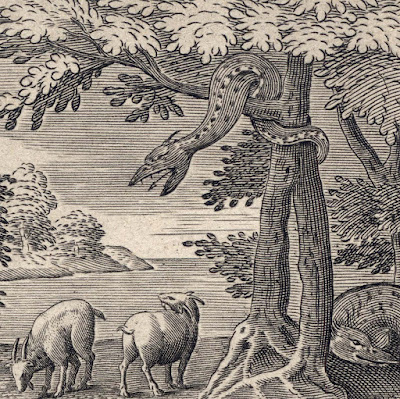Carel van Mallery (aka Charles de
Mallery) (1571–1635?)
“The Killing of Giant Indian Watersnakes
Using Fire”, c1596, after Jan van der Straet (aka Johannes Stradanus;
Giovanni della Strada; Jan van der Straeten; Giovanni Statenensis; Giovanni
Stradano; Joannes Stradanus) (1523–1605), plate 44 from the second edition (in
the first edition this plate was numbered “16”) from the series of 104 plates
dedicated to the jurist, Henricus van Osthoorn en Sonnevelt, “Venationes
Ferarum, Avium, Piscium” (with wild beasts, birds, fish), published by Philips
Galle (1537–1612) in Antwerp.
Engraving on laid paper trimmed along
the image borderline and backed with a support sheet.
Size: (sheet) 20.2 x 26.2 cm
Inscribed on plate within the image borderline:
(on lower flame left of centre) “'I. Stradanus inv. / C. de Mallery sculp. /
Phls Galle exc.”
Numbered on plate below the image
borderline: (left corner) “44.”
Lettered on plate in two lines of Latin
text in two below the image borderline: “Ingentem vegeto Serpentem corpore
gignit / India, qui solitus latitare in aquis, fame pressus // Prodit, et vmbrosa
dependens arbore, saltu / Apprendit pecus: ast clauis flammaq[ue] necatur.”
State ii? (of iv) (Note: my attribution
of this impression to the second state is based on the first state impression
held by the Rijksmuseum [RP-P-OB-31.574] has the plate number, “16”, and this
impression with number, “44”, matches the second state reproduced in Alessandra
Baroni & Manfred Sellink 2012, “Stradanus 1523–1605: Court Artist of the
Medici”, Brepols, Turnhout, p. 251. Nevertheless, the impression may be from a
later state as the numbers, “XVI”, that should be on the lower right corner in
the margin are either erased or have been trimmed off. I do not have
information about the attributes of states iii and iv.)
New Hollstein Dutch 481; Baroni Vannucci
1997 693.44 (Alessandra Baroni Vannucci 1997, “Jan van der Straet, detto
Giovanni Stradano, flandrus pictor et inventor”, Milan, Jandi Sapi Editori)
The Rijksmuseum offers the following
description of this print:
(transl.) “Several Indian water snakes
are chased out of the bush by fire. Then they are beaten to death with a club.
The print has a Latin caption and is part of a series about hunting scenes.”
See also the description of the print in
its first state at the British Museum:
“The Killing of Giant Indian Watersnakes
Using Fire; in the foreground, to left, giant Indian snakes burn in a pile of
vegetation; behind a group of men feed the flames with torches and attack the
snakes with clubs; in the distance, at the upper right, a snake catches sight
of two goats from the branch of a tree; beyond, another snake swallows a goat”
Condition: Well-inked and well-printed,
crisp impression with a printer’s crease (i.e. a crease occurring during the
printing process that creates a white “unprinted line”) at the centre top. The
sheet is in very good condition (i.e. there are no tears, holes, abrasions,
stains or foxing) trimmed along the image borderline and backed with a support
sheet of archival (millennium quality) washi paper.
I am selling this exceptionally rare,
engraving from the late 1500s for a total cost of AU$277 (currently US$204.93/EUR175.84/GBP156.27
at the time of this listing) including
postage and handling to anywhere in the world (but not, of course, any import
duties/taxes imposed by some countries).
If you are interested in purchasing this
curious image of “giant Indian watersnakes” hunting cattle while being hunted
with fire, please contact me (oz_jim@printsandprinciples.com) and I will send
you a PayPal invoice to make the payment easy.
This print has been sold
I admit that I do not know much about
the dragon-like beasts that the title of this marvellously animated engraving advises
me are “giant Indian watersnakes.” To be very honest I should put my hand up
and state that I know nothing about them beyond noticing that they have clearly
strayed a long way from their water habitat.
What I do know, however, is that this
composition is a remarkably clever graphic representation of the snakes,
foliage and fire pictorially woven together. I especially love the treatment of
the clouds of smoke cast up from the large tongues of flame as the concentric rings
of lines representing the smoke connote an appropriate idea of transparency and
ambiguity of form to the smoke-cloud mass. Note also the way that the tree seen
in front of the attacking men wielding their flaming touches and lethally lumpy
clubs pictorially “interrupts” our view of what they are doing and how this
interruption helps to create the illusion of animation.









No comments:
Post a Comment
Please let me know your thoughts, advice about inaccuracies (including typos) and additional information that you would like to add to any post.